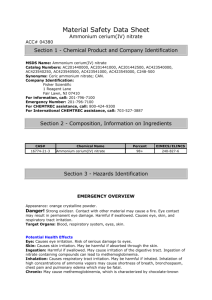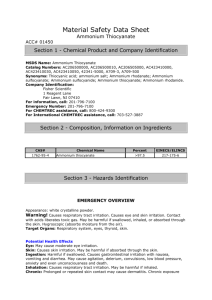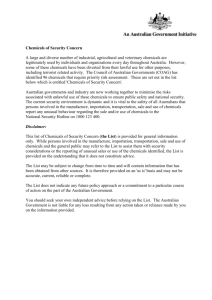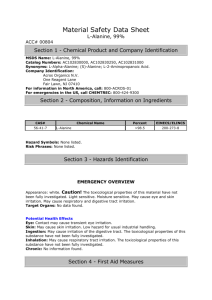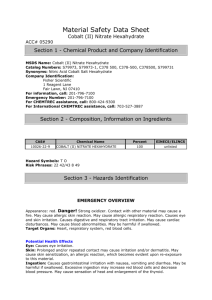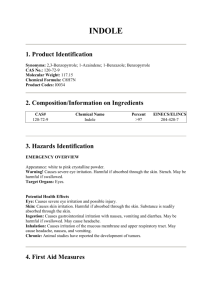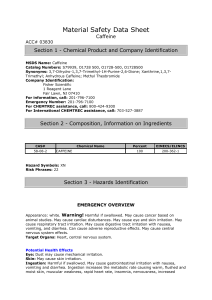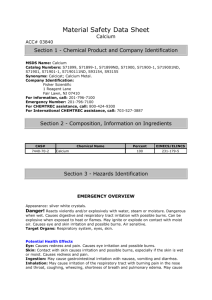Material Safety Data Sheet Ammonium Nitrate ACC# 01290 Section
advertisement
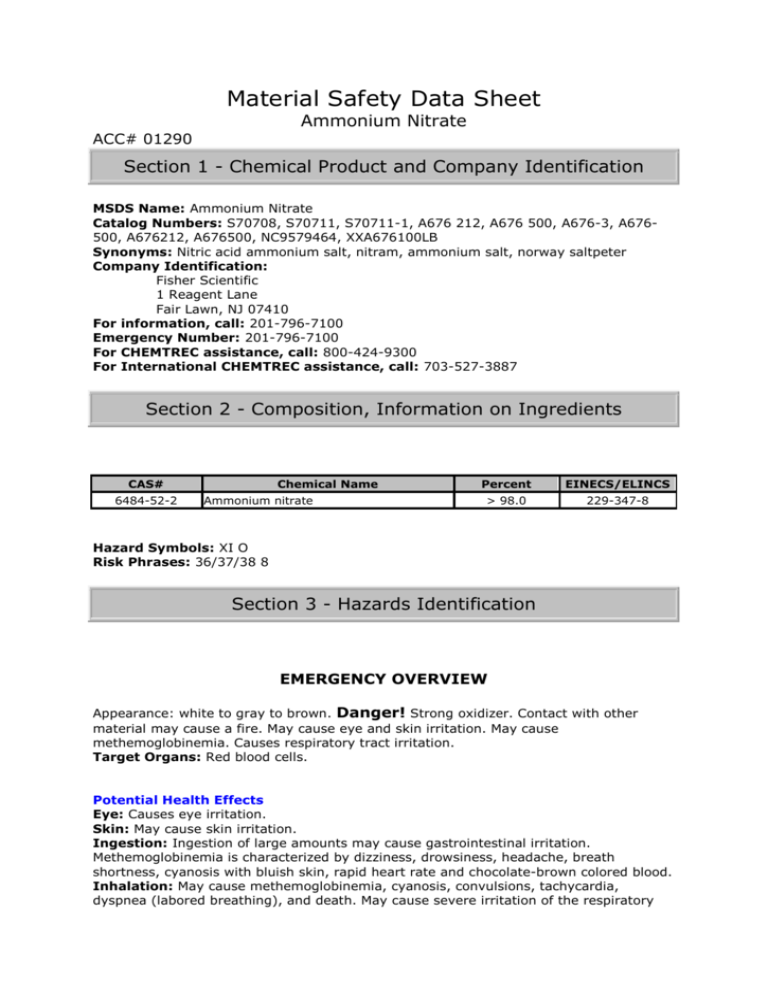
Material Safety Data Sheet Ammonium Nitrate ACC# 01290 Section 1 - Chemical Product and Company Identification MSDS Name: Ammonium Nitrate Catalog Numbers: S70708, S70711, S70711-1, A676 212, A676 500, A676-3, A676500, A676212, A676500, NC9579464, XXA676100LB Synonyms: Nitric acid ammonium salt, nitram, ammonium salt, norway saltpeter Company Identification: Fisher Scientific 1 Reagent Lane Fair Lawn, NJ 07410 For information, call: 201-796-7100 Emergency Number: 201-796-7100 For CHEMTREC assistance, call: 800-424-9300 For International CHEMTREC assistance, call: 703-527-3887 Section 2 - Composition, Information on Ingredients CAS# 6484-52-2 Chemical Name Ammonium nitrate Percent EINECS/ELINCS > 98.0 229-347-8 Hazard Symbols: XI O Risk Phrases: 36/37/38 8 Section 3 - Hazards Identification EMERGENCY OVERVIEW Appearance: white to gray to brown. Danger! Strong oxidizer. Contact with other material may cause a fire. May cause eye and skin irritation. May cause methemoglobinemia. Causes respiratory tract irritation. Target Organs: Red blood cells. Potential Health Effects Eye: Causes eye irritation. Skin: May cause skin irritation. Ingestion: Ingestion of large amounts may cause gastrointestinal irritation. Methemoglobinemia is characterized by dizziness, drowsiness, headache, breath shortness, cyanosis with bluish skin, rapid heart rate and chocolate-brown colored blood. Inhalation: May cause methemoglobinemia, cyanosis, convulsions, tachycardia, dyspnea (labored breathing), and death. May cause severe irritation of the respiratory tract with sore throat, coughing, shortness of breath and delayed lung edema. Methemoglobinemia is characterized by dizziness, drowsiness, headache, breath shortness, cyanosis with bluish skin, rapid heart rate and chocolate-brown blood. Inhalation can cause systemic acidosis and methemoglobinemia. Chronic: May cause methemoglobinemia, which is characterized by chocolate-brown colored blood, headache, weakness, dizziness, breath shortness, cyanosis (bluish skin due to deficient oxygenation of blood), rapid heart rate, unconsciousness and possible death. May cause digestive tract disturbances. Section 4 - First Aid Measures Eyes: Flush eyes with plenty of water for at least 15 minutes, occasionally lifting the upper and lower eyelids. Get medical aid. Skin: Get medical aid. Flush skin with plenty of soap and water for at least 15 minutes while removing contaminated clothing and shoes. Ingestion: If victim is conscious and alert, give 2-4 cupfuls of milk or water. Never give anything by mouth to an unconscious person. Get medical aid. Inhalation: Remove from exposure to fresh air immediately. If not breathing, give artificial respiration. If breathing is difficult, give oxygen. Get medical aid. Notes to Physician: Absorption of this product into the body may cause cyanosis (bluish discoloration of skin due to deficient oxygenation of the blood). Moderate degrees of cyanosis need to be treated only by supportive measures: bed rest and oxygen inhalation. For methemoglobinemia, administer oxygen alone or with Methylene blue depending on the methemoglobinemia concentration in the blood. Cleansing of the entire contaminated area of the body is of utmost importance. Section 5 - Fire Fighting Measures General Information: Strong oxidizer. Contact with combustible materials may cause a fire. Wear appropriate protective clothing to prevent contact with skin and eyes. Wear a self-contained breathing apparatus (SCBA) to prevent contact with thermal decomposition products. May explode under confinement and high temperatures, especially if contaminated. Extinguishing Media: Use water spray to cool fire-exposed containers. Use flooding quantities of water. Section 6 - Accidental Release Measures General Information: Use proper personal protective equipment as indicated in Section 8. Spills/Leaks: Vacuum or sweep up material and place into a suitable disposal container. Clean up spills immediately, observing precautions in the Protective Equipment section. Avoid generating dusty conditions. Remove all sources of ignition. Section 7 - Handling and Storage Handling: Use with adequate ventilation. Minimize dust generation and accumulation. Avoid contact with eyes, skin, and clothing. Empty containers retain product residue, (liquid and/or vapor), and can be dangerous. Keep container tightly closed. Avoid contact with heat, sparks and flame. Avoid contact with clothing and other combustible materials. Avoid ingestion and inhalation. Keep away from clothing and other combustible materials. Do not pressurize, cut, weld, braze, solder, drill, grind, or expose empty containers to heat, sparks or open flames. Storage: Keep away from sources of ignition. Do not store near combustible materials. Store in a tightly closed container. Store in a cool, dry, well-ventilated area away from incompatible substances. Keep away from acids. Keep away from reducing agents. Do not store near alkaline substances. Section 8 - Exposure Controls, Personal Protection Engineering Controls: Use adequate ventilation to keep airborne concentrations low. Exposure Limits Chemical Name Ammonium nitrate ACGIH none listed NIOSH OSHA - Final PELs none listed none listed OSHA Vacated PELs: Ammonium nitrate: No OSHA Vacated PELs are listed for this chemical. Personal Protective Equipment Eyes: Wear appropriate protective eyeglasses or chemical safety goggles as described by OSHA's eye and face protection regulations in 29 CFR 1910.133 or European Standard EN166. Skin: Wear appropriate gloves to prevent skin exposure. Clothing: Wear appropriate protective clothing to minimize contact with skin. Respirators: Follow the OSHA respirator regulations found in 29CFR 1910.134 or European Standard EN 149. Always use a NIOSH or European Standard EN 149 approved respirator when necessary. Section 9 - Physical and Chemical Properties Physical State: solid Appearance: white to gray to brown Odor: odorless pH: 5.4 (0.1 M solution) Vapor Pressure: Negligible. Vapor Density: Not available. Evaporation Rate:Negligible. Viscosity: Not available. Boiling Point: 410 deg F Freezing/Melting Point:338 deg F Autoignition Temperature: Not applicable. Flash Point: Not available. Decomposition Temperature:210 deg C NFPA Rating: (estimated) Health: 1; Flammability: 0; Reactivity: 3 Explosion Limits, Lower:Not available. Upper: Not available. Solubility: 118% at 0 C Specific Gravity/Density:1.725 @ 25°C Molecular Formula:NH4NO3 Molecular Weight:80.0396 Section 10 - Stability and Reactivity Chemical Stability: Stable. However, may decompose if heated. Conditions to Avoid: Excess heat, combustible materials, organic materials, reducing agents, strong acids, powdered metals. Incompatibilities with Other Materials: Incompatible with acetic acid, aluminum, ammonium chloride, antimony bismuth, cadmium, carbon, chlorides, chromium cobalt, contaminat, copper, lead, magnesium, magnesium, copper sulfate(anhydrous) potassium chlorate and water, powdered metals, nickel, organic matter, phosphorus, potassium and ammonium sulfate, sodium, sodium hypochlorite, sodium perchlorate, sodium-potassium alloy and ammonium sulfate, sulfur, and zinc. Hazardous Decomposition Products: Oxides of nitrogen. Hazardous Polymerization: Has not been reported. Section 11 - Toxicological Information RTECS#: CAS# 6484-52-2: BR9050000 LD50/LC50: CAS# 6484-52-2: Oral, rat: LD50 = 2217 mg/kg;<BR. Carcinogenicity: CAS# 6484-52-2: Not listed by ACGIH, IARC, NIOSH, NTP, or OSHA. Epidemiology: No data available. Teratogenicity: No data available. Reproductive Effects: No data available. Neurotoxicity: No data available. Mutagenicity: No data available. Other Studies: No data available. Section 12 - Ecological Information No information available. Section 13 - Disposal Considerations Chemical waste generators must determine whether a discarded chemical is classified as a hazardous waste. US EPA guidelines for the classification determination are listed in 40 CFR Parts 261.3. Additionally, waste generators must consult state and local hazardous waste regulations to ensure complete and accurate classification. RCRA P-Series: None listed. RCRA U-Series: None listed. Section 14 - Transport Information US DOT Shipping Name: Hazard Class: UN Number: IATA RID/ADR IMO AMMONIUM NITRATE 5.1 UN1942 Packing Group: III Canada TDG AMMONIUM NITRATE 5.1 UN1942 III Section 15 - Regulatory Information US FEDERAL TSCA CAS# 6484-52-2 is listed on the TSCA inventory. Health & Safety Reporting List None of the chemicals are on the Health & Safety Reporting List. Chemical Test Rules None of the chemicals in this product are under a Chemical Test Rule. Section 12b None of the chemicals are listed under TSCA Section 12b. TSCA Significant New Use Rule None of the chemicals in this material have a SNUR under TSCA. SARA Section 302 (RQ) None of the chemicals in this material have an RQ. Section 302 (TPQ) None of the chemicals in this product have a TPQ. SARA Codes CAS # 6484-52-2: acute, flammable, reactive. Section 313 No chemicals are reportable under Section 313. Clean Air Act: This material does not contain any hazardous air pollutants. This material does not contain any Class 1 Ozone depletors. This material does not contain any Class 2 Ozone depletors. Clean Water Act: None of the chemicals in this product are listed as Hazardous Substances under the CWA. None of the chemicals in this product are listed as Priority Pollutants under the CWA. None of the chemicals in this product are listed as Toxic Pollutants under the CWA. OSHA: None of the chemicals in this product are considered highly hazardous by OSHA. STATE CAS# 6484-52-2 can be found on the following state right to know lists: New Jersey, Florida, Pennsylvania, Massachusetts. California No Significant Risk Level: None of the chemicals in this product are listed. European/International Regulations European Labeling in Accordance with EC Directives Hazard Symbols: XI O Risk Phrases: R 36/37/38 Irritating to eyes, respiratory system and skin. R 8 Contact with combustible material may cause fire. Safety Phrases: S 17 Keep away from combustible material. S 26 In case of contact with eyes, rinse immediately with plenty of water and seek medical advice. S 37/39 Wear suitable gloves and eye/face protection. WGK (Water Danger/Protection) CAS# 6484-52-2: 1 Canada CAS# 6484-52-2 is listed on Canada's DSL List. CAS# 6484-52-2 is listed on Canada's DSL List. This product has a WHMIS classification of C, D2B, F. CAS# 6484-52-2 is not listed on Canada's Ingredient Disclosure List. Exposure Limits Section 16 - Additional Information MSDS Creation Date: 12/12/1997 Revision #3 Date: 1/16/2001 The information above is believed to be accurate and represents the best information currently available to us. However, we make no warranty of merchantability or any other warranty, express or implied, with respect to such information, and we assume no liability resulting from its use. Users should make their own investigations to determine the suitability of the information for their particular purposes. In no event shall Fisher be liable for any claims, losses, or damages of any third party or for lost profits or any special, indirect, incidental, consequential or exemplary damages, howsoever arising, even if Fisher has been advised of the possibility of such damages.
